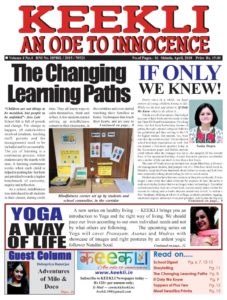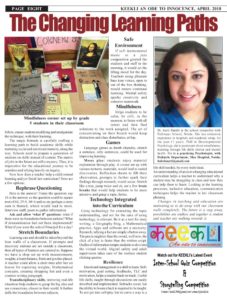 Dr. Aarti Bakshi
Dr. Aarti Bakshi
“Children are not things to be moulded, but people to be unfolded”- Jess Lair
School life is full of growth and change. For change to happen, all stakeholders involved (students, teaching staff, parents and the management) need to be included and be accountable. The joy of learning is a continuous process, when students carry the mantle with ease. A learning continuum works when each child is helped in pushing his / her limit and prodded towards a higher benchmark of curiosity, inquiry and reflection.
 As a school, mindfulness was introduced to all students in their classes, during circle time. They all learnt ways to calm themselves, think and reflect. A few students started setting up mindfulness corners in their classrooms, in the corridors and even started teaching their families at home. Techniques that touch their hearts, and are easy to follow, ensure students modifying and amalgamate the technique, with their learning.
As a school, mindfulness was introduced to all students in their classes, during circle time. They all learnt ways to calm themselves, think and reflect. A few students started setting up mindfulness corners in their classrooms, in the corridors and even started teaching their families at home. Techniques that touch their hearts, and are easy to follow, ensure students modifying and amalgamate the technique, with their learning.
The magic formula is carefully crafting a learning path to build academic skills while nurturing social and emotional maturity, along the way. Schools need to prepare a generation of students on skills instead of content. The matrix of jobs in the future are still a mystery. Thus, it is imperative for the educational journey to be seamless and relying heavily on inquiry.
Now how does a teacher help a child extend learning and yet finish her curriculum? Here are a few options:
Rephrase Questioning
Here is the answer! Frame the question: say 16 is the answer, so the question could be square root of 64, 25-9, 10+6 and so on; perhaps a story sum is framed, which would lead to more. Interview staff, peers to gather information.
Ask and allow ‘what if’ questions: what if there were no boundaries between nations? What if demonetization had not been implemented? What if you were the school Principal for a day?
Stretch Boundaries
Learning can and should be taken beyond the four walls of a classroom. If prompts and discovery stations are set outside a classroom, then all types of learners are catered to. Suppose we have a shop set up with measurements, weights, a beam balance, fruits and goodies placed. A teacher could allow a short time after her set lesson for exploring weights, Mathematical concepts, creating shopping list and even a creative writing paragraph.
Transdisciplinary skills, mirroring real-life situations help students to grasp the big idea and see connections, closest to their world. It further dulls the boundaries between subjects.
Safe Environment
If soft instrumental music or a jazz composition greeted the students and staff in the morning, it would set the lifting mood for the day. Teachers using pleasant base tone voices, open to out of the box thinking, would ensure continual learning. Mental safety sparks creativity and cohesive teamwork.
Mindfulness
Helps students to be calm, be still, in the moment, to listen with all intent and then find solutions to the work assigned. The art of concentrating on their breath would keep distraction and class disturbance, at bay.
Games
Language games as dumb charades, stretch a sentence, silly sentences, could be used for improving learning.
Messy play: students enjoy material exploration through play. A corner set up with various textures, materials, would lead to varied discoveries. Reflection sheets to fill their observation, prompts to further spark their findings through research, would occur. Stretch like a tree, jump twice and sit, are a few brain breaks that would help students to be more attentive and grasp a topic, better.
Technology Integrated into the Curriculum
Using technology for extending the topic understanding, and not for the sake of using technology, is relevant. Be it as a tool for story writing, a Geography blog, a Mathematical practice, Apps and software are a necessity. Research, tallying a fact are simply a button away. The pen is mightier than the sword, well now, the click of a key is faster than the written script. Oodles of information tempts students to dive into the virtual world. Digital safety and adult supervision takes care of the restless student clicking queries.
Resilience
Emotional management is a skill to learn. Self-motivation, goal setting, feedbacks, TLC and motivation, helps a student back on track. Useful life skills, taught through discussions are easily absorbed and implemented. Setbacks occur, but the ability to bounce back is required to be taught. To not get into self-pity, but to carve a way is a life skill needed, by every individual.
An understanding of an ever-changing educational curriculum helps a teacher to understand why a student may be struggling in class and how they can help them to learn. Looking at the learning processes, inclusive education, communication techniques helps the teacher in her classroom planning.
Changes in teaching and education are motivating us to do away with our classroom walls completely. The future is a step away, possibilities are endless and together a student and teacher are walking towards it.
(Dr. Aarti Bakshi is the school counsellor with Pathways School, Noida. She has extensive experience in hospitals and academic setup, for the past 11 years. PhD in Developmental Psychology, she is passionate about mindfulness, teaching through life skills stories and mental health. She is a practicing Psychologist, with Pediatric Department, Max Hospital, Noida)





